How Long Does It Take To Read The Scarlet Letter
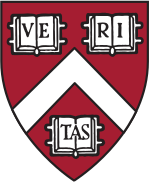 | |
| Blazon | Private undergraduate higher |
|---|---|
| Established | 1636 (1636) |
| Parent institution | Harvard University |
| Dean | Rakesh Khurana |
| Students | 6,755[ane] |
| Location | Cambridge Massachusetts United States |
| Campus | Urban |
| Website | higher |
Harvard Higher is the undergraduate higher of Harvard University, a private Ivy League research university in Cambridge, Massachusetts. Part of the Faculty of Arts and Sciences, Harvard College is Harvard Academy's traditional undergraduate programme, offering AB and SB degrees. It is highly selective, with fewer than five per centum of applicants beingness offered admission in contempo years.[two] [3] Harvard College students participate in more than than 450 extracurricular organizations[4] and near all alive on campus—showtime-year students in or virtually Harvard Thou, and upperclass students in twelve "houses".
History [edit]
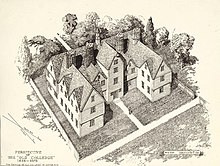
First building of Harvard College 1638–1670
The schoolhouse came into existence in 1636 by vote of the Great and Full general Court of the Massachusetts Bay Colony—though without a single building, instructor, or student. In 1638, the higher became home for North America'south first known printing printing, carried past the ship John of London.[5] [6] Iii years afterwards, the college was renamed in award of deceased Charlestown minister John Harvard (1607–1638) who had ancestral to the school his unabridged library and half of his monetary estate.
Harvard's first headmaster was Nathaniel Eaton (1610–1674); in 1639, he likewise became its get-go teacher to be dismissed, for overstrict bailiwick.[7] The schoolhouse'southward beginning students were graduated in 1642.
The Harvard Indian Higher was established, with the capacity for four or five Native Americans, and in 1665 Caleb Cheeshahteaumuck (c. 1643–1666) "from the Wampanoag … did graduate from Harvard, the first Indian to exercise and then in the colonial period."[8]

Harvard Higher in Colonial times
The colleges of England's Oxford and Cambridge Universities are communities within the larger university, each an association of scholars sharing room and board. Harvard's founders may have envisioned it as the start in a series of sibling colleges on the English model which would eventually establish a university—though no further colleges materialized in colonial times. The Indian College was active from 1640 to no later than 1693, but it was a minor addition not operated in federation with Harvard co-ordinate to the English model. Harvard began granting college degrees in the late eighteenth century, and it was increasingly styled Harvard University, fifty-fifty every bit Harvard College was increasingly thought of as the academy'southward undergraduate partitioning in item. [ citation needed ]
Currently, Harvard College is responsible for undergraduate admissions, advising, housing, student life, and athletics—generally all undergraduate matters except pedagogy, which is the purview of the Harvard Faculty of Arts and Sciences. The body known as the President and Fellows of Harvard Higher retains its traditional name despite having governance of the unabridged university. Radcliffe College, established in 1879, originally paid Harvard faculty to repeat their lectures for women.[9] Since the 1970s, Harvard has been responsible for undergraduate matters for women, though women's Harvard diplomas were countersigned by the President of Radcliffe until a terminal merger in 1999.[10]
Admissions [edit]

Access is based on academic prowess, extracurricular activities, and personal qualities. For the undergraduate class of 2025, Harvard had 57,435 applications and accepted 1,968 (3.iv% acceptance rate). For the undergraduate class of 2023, the middle 50% range of SAT scores of enrolled freshmen was 710–770 for reading and writing and 750–800 for math, while the eye 50% range of the Human activity composite score was 33–35. The boilerplate high school form point average (GPA) was 4.xviii.[1] The acceptance rate for transfer students has been approximately i%.[12] Harvard consistently ranks first in the enrollment of recipients of the National Merit $two,500 Scholarship; it enrolled 207 such scholars in the Class of 2022.[13]
Harvard Higher ended its early admissions program in 2007, simply for the class of 2016 and beyond, an early activeness programme was reintroduced.[14] The freshman class that entered in the fall of 2017 was the first to be majority (50.8%) nonwhite.[xv]
A federal lawsuit alleges that Harvard'due south admissions policies discriminate confronting Asian Americans, who tend to exist overrepresented among students with high academic achievement.[16] [17] A 2019 district court determination in the instance (which has since been appealed) plant no prove of explicit racial bias but did not rule out a small amount of implicit bias.[18] Harvard has implemented more than implicit bias grooming for its admissions staff in accordance with the court'southward recommendations.[19] [xx] In addition, Harvard'due south admissions preference for children of alumni, employees, and donors has been criticized as favoring white and wealthy candidates.[21] [22] [23]
The median family income of Harvard students is $168,800, with 53% of students coming from the top 10% highest-earning families and 20% from the bottom 60%.[24] As of 2019, Harvard Higher tuition was almost $48,000 and total costs about $seventy,000. However, Harvard offers one of the most generous financial aid programs in the United States, with need-blind admission and 100% of fiscal need met for all students. Families with incomes below $65,000 pay nothing for their children to attend, while families earning upwardly to $150,000 pay no more than 10% of their annual incomes. Financial assist is solely based on need; no merit or athletic scholarships are offered.[25]
Academics [edit]
The four-yr, full-time undergraduate plan has a liberal arts and sciences focus.[26] [27] To graduate in the usual four years, undergraduates ordinarily take four courses per semester.[28]
Midway through the 2d twelvemonth, virtually undergraduates join 1 of fifty bookish majors; many as well declare a minor (secondary field). Articulation majors (combining the requirements of two majors) and special majors (of the student's own pattern) are likewise possible.[27] Most majors atomic number 82 to the Artium Baccalaureus (AB). Some honor the Scientiae Baccalaureus (SB). There are also dual degree programs permitting students to earn both a Harvard AB and a Principal of Music (MM) from either the New England Conservatory of Music or the Berklee College of Music over five years.[29] In almost majors, an honors degree requires advanced coursework and/or a senior thesis.[30]
Harvard Higher students must take a grade in each of 4 General Educational activity categories (Aesthetics and Culture; Ethics and Civics; Histories, Societies, Individuals; Scientific discipline and Technology in Order)[31] besides every bit a course in each of three academic divisions (Arts and Humanities; Social Sciences; Science and Applied science and Applied Science). They must as well fulfill foreign linguistic communication, expository writing, and quantitative reasoning with data requirements.[31] Exposure to a range of intellectual areas in parallel with pursuit of a chosen major in depth fulfills the injunction of one-time Harvard president Abbott Lawrence Lowell that liberal education should produce "men who know a trivial of everything and something well".[32]
Some introductory courses have large enrollments, just most courses are small: the median grade size is 12 students.[33] Funding and faculty mentorship for enquiry is available in all disciplines for undergraduates at all levels.[34]
Student life [edit]
Business firm system [edit]

Nearly all undergraduates live on campus, for the beginning year in dormitories in or near Harvard G and later in the upperclass houses—administrative subdivisions of the higher likewise every bit living quarters, providing a sense of community in what might otherwise be a socially incohesive and administratively daunting university environment. Each house is presided over by two faculty deans, while its Allston Burr Resident Dean—usually a junior faculty member—supervises undergraduates' day-to-mean solar day academic and disciplinary well-being.
The faculty deans and resident dean are assisted past other members of the Senior Common Room—select graduate students (tutors), faculty, and university officials brought into voluntary association with each house. The faculty deans and resident dean reside in the house, as exercise resident tutors. Terms similar tutor, Senior Common Room, and Junior Mutual Room reflect a debt to the constituent college systems at Oxford and Cambridge from which Harvard'south organisation took inspiration.[35]
The houses were created past President Lowell in the 1930s to gainsay what he saw as pernicious social stratification engendered by the private, off-campus living arrangements of many undergraduates at that time. Lowell's solution was to provide every homo—Harvard was male-only at the fourth dimension—with on-campus accommodations throughout his time at the college; Lowell also saw slap-up benefits in other features of the business firm system, such as the relaxed discussions—academic or otherwise—which he hoped would take place among undergraduates and members of the Senior Mutual Room over meals in each house's dining hall.[36]

How students come to alive in particular houses has changed profoundly over fourth dimension. Nether the original "typhoon" system, masters (now chosen "faculty deans") negotiated privately over the assignment of students.[ citation needed ] From the 1960s to the mid-1990s, each student ranked the houses co-ordinate to personal preference, with a lottery resolving the oversubscription of more popular houses. Today, groups of ane to eight freshmen form a block which is then assigned, essentially at random, to an upperclass house.
The nine "River Houses" are south of Harvard Yard, well-nigh the Charles River: Adams, Dunster, Eliot, Kirkland, Leverett, Lowell, Mather, Quincy, and Winthrop. Their construction was financed largely by a 1928 gift from Yale alumnus Edward Harkness, who, frustrated in his attempts to initiate a similar project at his alma mater, eventually offered $xi meg to Harvard.[a] [40] Two of the houses, Dunster and Lowell, were completed in 1930.[37]
Structure of the start houses began in 1929,[37] only the land on which they were built had been assembled decades before. After graduating from Harvard in 1895, Edward Due west. Forbes found himself inspired by the Oxford and Cambridge systems during two years of study in England; on returning to the United States he set out to acquire the land between Harvard G and the Charles River that was not already owned by Harvard or an associated entity. By 1918, that appetite had been largely fulfilled and the assembled land transferred to Harvard.[41] [42]
The three "Quad Houses" enjoy a residential setting half a mile northwest of Harvard Yard. These were built past Radcliffe Higher and housed Radcliffe College students until the Harvard and Radcliffe residential systems merged in 1977.[43] They are Cabot, Currier, and Pforzheimer Business firm. A thirteenth house, Dudley House, is nonresidential simply fulfills, for some graduate students and the (very few) undergraduates living off campus, the authoritative and social functions provided to on-campus residents by the other twelve houses. Harvard's residential houses are paired with Yale's residential colleges in sister relationships.
Student regime [edit]
The Harvard Undergraduate Quango (UC) was the student regime of Harvard College until it was abolished by a student plebiscite in 2022.[44] It was replaced by the Harvard Undergraduate Association (HUA).[45]
Athletics [edit]
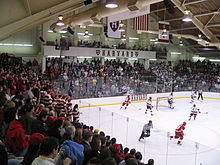
The Harvard Red fields 42 intercollegiate sports teams in the NCAA Division I Ivy League, more than any other NCAA Partitioning I college in the country.[46] Every ii years, the Harvard and Yale track and field teams come together to compete against a combined Oxford and Cambridge team in the oldest continuous international amateur contest in the world.[47] As with other Ivy League universities, Harvard does not offer athletic scholarships.[48]
Harvard's athletic rivalry with Yale is intense in every sport in which they meet, coming to a climax each fall in the almanac football coming together, which dates back to 1875 and is usually chosen simply "The Game". While Harvard'southward football game team is no longer one of the best as it was in football game's early on days, both Harvard and Yale have influenced the fashion the game is played. In 1903, Harvard Stadium introduced a new era into football with the first permanent reinforced concrete stadium of its kind in the country.[49] [fifty]
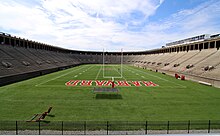
Even older than Harvard–Yale football rivalry, the Harvard–Yale Regatta is held each June on the Thames River in eastern Connecticut. The Harvard crew is typically considered to be one of the pinnacle teams in the land in rowing. Other sports in which Harvard teams are particularly stiff are men'south ice hockey, squash, and men's and women's fencing. Harvard's men'south water ice hockey team won the school's beginning NCAA Championship in whatsoever squad sport in 1989, and Harvard also won the Intercollegiate Sailing Association National Championships in 2003. Harvard was the start Ivy League school to win an NCAA Title in a women'south sport when its women's lacrosse team won in 1990.[51]
The school color is carmine, which is also the proper noun of Harvard's sports teams and the student newspaper, The Harvard Crimson. The colour was unofficially adopted (in preference to magenta) by an 1875 vote of the educatee torso, although the association with some class of crimson tin can be traced back to 1858, when Charles William Eliot, a immature graduate student who would later become Harvard's 21st and longest-serving president (1869–1909), bought red bandanas for his coiffure so they could more easily exist distinguished by spectators at a regatta.[52]
Fight songs [edit]
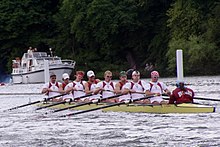
Harvard has several fight songs, the most played of which, especially at football game, are "Ten Grand Men of Harvard" and "Harvardiana". While "Fair Harvard" is really the alma mater, "X Thousand Men" is amend known outside the university. The Harvard University Band performs these fight songs and other thank you at football game and hockey games. These were parodied past Harvard alumnus Tom Lehrer in his song "Fight Fiercely, Harvard", which he composed while an undergraduate.
Athletics history [edit]
By the late 19th century, critics of intercollegiate athletics, including Harvard president Charles William Eliot, believed that sports had go over-commercialized and took students away from their studies. They called for limitations on all sports. This opposition prompted Harvard's athletic committee to target "minor" sports—basketball and hockey—for reform in order to deflect attending from the major sports: football game, baseball, track, and coiffure. The committee made information technology difficult for the basketball team to operate by denying financial assistance and limiting the number of overnight away games in which the team could participate.
Student organizations [edit]
Harvard has more 450 undergraduate student organizations.[4] [53] The Phillips Brooks House Association acts as an umbrella service arrangement.
Notable alumni [edit]
- Notable alumni include:
-

Writer, political activist, and lecturer Helen Keller (AB,1904, Radcliffe College)
-
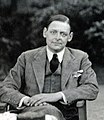
Poet and Nobel laureate in literature T. S. Eliot (AB,1909)
-

US secretarial assistant of country and Nobel laureate in peace Henry Kissinger (AB,1950)
-

United states vice president and Nobel laureate in peace Al Gore (AB,1969)
-

11th Prime number Government minister of Pakistan Benazir Bhutto (AB,1973, Radcliffe College)
-

Philosopher, political activist, and social critic Cornel West (AB,1973)
Footnotes [edit]
- ^ [37] [38] Harkness' gift was anonymous, at least at first. "I have forgotten the gentleman's name," Harvard's President Lowell told the faculty in making the initial announcement. "I told him I would."[39]
- ^ a b Nominal Harvard College course yr: did not graduate
References [edit]
- ^ a b "Common Information Ready 2019-2020" (PDF). Role of Institutional Enquiry. Harvard University. Archived (PDF) from the original on 26 June 2020. Retrieved 23 June 2020.
- ^ "Record-Low 4.59 Per centum of Applicants Accustomed to Harvard Class of 2022". The Harvard Crimson. 29 March 2018. Archived from the original on 9 Nov 2020. Retrieved sixteen September 2019.
- ^ "Tape-Low iv.5 Percent of Harvard College Applicants Accepted to Class of 2023". The Harvard Crimson. 29 March 2019. Archived from the original on 12 Nov 2020. Retrieved sixteen September 2019.
- ^ a b "Student Activities". Archived from the original on 24 Oct 2020. Retrieved 7 Dec 2019.
- ^ "The musical instrument behind New England'due south first literary flowering". Harvard University. Archived from the original on 2016-07-eleven. Retrieved 2014-01-eighteen .
- ^ "Rowley and Ezekiel Rogers, The Beginning North American Printing Press" (PDF). Maritime Historical Studies Heart, University of Hull. Archived (PDF) from the original on 2013-01-23. Retrieved 2014-01-18 .
- ^ Samuel Eliot Morison, Iii Centuries of Harvard, 1636–1936 (1986)
- ^ Monaghan, E. J., 2005, p. 55, 59
- ^ Schwager, Sally (2004). "Taking up the Challenge: The Origins of Radcliffe". In Laurel Thatcher Ulrich (ed.). Yards and Gates: Gender in Harvard and Radcliffe History. New York: Palgrave Macmillan. pp. 87–115. ISBN1403960984.
- ^ Radcliffe Enters Historic Merger With Harvard. The Harvard Blood-red (Report). Archived from the original on October 11, 2017. Retrieved May half-dozen, 2016.
- ^ Harvard College. "A Cursory History of Harvard College". Harvard College. Archived from the original on 2011-04-24. Retrieved 2011-07-25 .
- ^ Menz, Petey. "The Real one%: Harvard Admits 15 Transfer Students". The Harvard Scarlet. Archived from the original on nine April 2021. Retrieved xiv June 2021.
- ^ "NMSC 2018–2019 Annual Written report" (PDF). National Merit Scholarship Corporation.
- ^ Finder, Alan; Arenson, Karen West. (September 12, 2006). "Harvard Ends Early Admission". The New York Times. Archived from the original on November 21, 2020. Retrieved August 1, 2020.
- ^ Fernandes, Deirdre (August 3, 2017). "The bulk of Harvard'due south incoming grade is nonwhite". The Boston Earth. Archived from the original on November 11, 2020. Retrieved August four, 2017.
- ^ "Harvard'southward Ongoing Anti-Asian-American Micro-Aggression". National Review. 2018-06-nineteen. Archived from the original on 2019-03-23. Retrieved 2018-07-17 .
- ^ "A lawsuit reveals how peculiar Harvard'southward definition of merit is". The Economist. Archived from the original on 2018-07-17. Retrieved 2018-07-17 .
- ^ "Harvard Won a Key Affirmative Action Battle. But the War's Not Over". The New York Times. October 2, 2019. Archived from the original on December 14, 2019. Retrieved December 14, 2019.
- ^ "Local Reaction To The Ruling In The Harvard Admission's Example". Archived from the original on 2019-12-29. Retrieved 2020-08-01 .
- ^ "In Wake of Admissions Lawsuit Decision, Khurana Agrees Harvard Must Become Aware of Biases". The Crimson. 23 October 2019. Archived from the original on ane August 2020. Retrieved 29 Dec 2019.
- ^ Gilded, Daniel (January 15, 2003). "Admissions Preferences Given to Alumni Children Draws Fire". The Wall Street Journal. Archived from the original on August 12, 2018. Retrieved August 1, 2020.
- ^ Golden, Daniel (2006). The Price of Access: How America's Ruling Class Buys Its Way into Elite Colleges—and Who Gets Left Outside the Gates. ISBNi-4000-9796-7.
- ^ Todd, Sarah. "A new statistic reveals the startling privilege of white kids admitted to Harvard". Quartz. Archived from the original on 12 November 2020. Retrieved 19 June 2020.
- ^ Aisch, Gregor; Buchanan, Larry; Cox, Amanda; Quealy, Kevin (18 January 2017). "Economic multifariousness and student outcomes at Harvard". The New York Times. Archived from the original on nine December 2020. Retrieved 9 August 2020.
- ^ "How Help Works". Archived from the original on Dec 12, 2020. Retrieved December eight, 2019.
- ^ "Carnegie Classifications – Harvard University". The Carnegie Foundation for the Advancement of Didactics. Archived from the original on August vii, 2020. Retrieved August 28, 2010.
- ^ a b "Liberal Arts & Sciences". Harvard Higher. Archived from the original on Oct 5, 2021. Retrieved December sixteen, 2019.
- ^ "The Bachelor of Arts and Available of Science Degrees". Harvard College. Archived from the original on December 7, 2019. Retrieved December 8, 2019.
- ^ "Dual Degree Music Programs". Harvard College. Archived from the original on Dec vii, 2019. Retrieved December 16, 2019.
- ^ "Academic Information: The Concentration Requirement". Handbook for Students. Harvard College. Archived from the original on Dec 5, 2010. Retrieved Baronial 28, 2010.
- ^ a b "Requirements". Archived from the original on December 13, 2019. Retrieved November 22, 2019.
- ^ Lewis, Harry R. (2007). Excellence Without a Soul: Does Liberal Education Take a Future?. PublicAffairs. p. 48. ISBN9781586485375.
- ^ "How large are classes?". Harvard Higher. Archived from the original on April xiv, 2021. Retrieved December 16, 2019.
- ^ "Research". Harvard College. Archived from the original on December 7, 2019. Retrieved December 16, 2019.
- ^ Harvard College Role of Residential Life (2008). "History of the House System". Retrieved 2008-04-20 . [ permanent dead link ]
- ^ Morison, Samuel Eliot (1936). 3 Centuries of Harvard: 1636–1936 . Cambridge, Mass., Harvard University Press. pp. 476–478.
- ^ a b c Bethell, John (1998). Harvard Observed: An Illustrated History of the Academy in the Twentieth Century . Cambridge: Harvard Academy Press. pp. 102–103. ISBN9780674377332.
- ^ "Gifts – 1928–1929" (Printing release). Harvard Academy News Function. June xx, 1929. HU 37.five, Harvard Academy Athenaeum, Cambridge, Massachusetts "This figure [of gifts and legacies received during the twelvemonth] includes $v,444,000 received from E. S. Harkness to defray the expenses of constructing the first Harvard houses."
- ^ John B. Fox Jr. (2007). The Kinesthesia of Arts and Sciences at Harvard University, 1686–1933. President and Fellows of Harvard Higher. p. 142.
- ^ "Harkness and History". Harvard Magazine. Nov 2013. Archived from the original on 27 May 2015. Retrieved 11 November 2015.
- ^ Lowe, Charles U. "The Forbes Story of the Harvard Riverside Assembly: How Harvard Acquired the Land on which Lowell House was Built," February 20, 2002.lowell.harvard.edu Archived 2010-04-09 at the Wayback Car
- ^ Sacks, Benjamin J. "Harvard'southward 'Constructed Utopia' and the Culture of Deception: the Expansion toward the Charles River, 1902–1932," The New England Quarterly 84.two (June 2011): 286–317.[1] Archived 2019-04-18 at the Wayback Motorcar
- ^ Sofen, Adam A. "Radcliffe Enters Historic Merger With Harvard, April 21, 1999.[two] Archived 2011-07-17 at the Wayback Motorcar
- ^ "Harvard Students Vote Overwhelmingly to Dissolve Undergraduate Quango in Favor of New Educatee Authorities | News | The Harvard Red". world wide web.thecrimson.com . Retrieved 2022-05-23 .
- ^ "Estabine and Johnson Elected as First Co-Presidents of the Harvard Undergraduate Association | News | The Harvard Ruby". www.thecrimson.com . Retrieved 2022-05-23 .
- ^ "Harvard : Women'southward Rugby Becomes 42nd Varsity Sport at Harvard Academy". Gocrimson.com. Baronial 9, 2012. Archived from the original on September 29, 2013. Retrieved July 5, 2013.
- ^ "Yale and Harvard Defeat Oxford/Cambridge Team". Yale Academy Athletics. Archived from the original on Oct 13, 2011. Retrieved September 13, 2011.
- ^ "The Harvard Guide: Financial Aid at Harvard". Harvard University. September two, 2006. Archived from the original on September 2, 2006. Retrieved Baronial 29, 2010.
- ^ "History of American Football game". Newsdial.com. Archived from the original on September 25, 2010. Retrieved August 29, 2010.
- ^ Nelson, David M., Anatomy of a Game: Football, the Rules, and the Men Who Made the Game, 1994, pp. 127–128
- ^ "Teammates for Life". Harvard Magazine. June 5, 2015. Archived from the original on December xv, 2019. Retrieved Dec fifteen, 2019.
- ^ https://world wide web.thecrimson.com/commodity/2002/four/11/harvard-explained-why-is-crimson-harvards/
- ^ "List of Student Organizations". The President and Fellows of Harvard College. Harvard College. Archived from the original on 12 January 2016. Retrieved 13 Jan 2016.
- ^ Barzilay, Karen Northward. "The Education of John Adams". Massachusetts Historical Society. Archived from the original on 2021-07-26. Retrieved 20 September 2020.
- ^ "John Quincy Adams". The White House. Archived from the original on 5 October 2021. Retrieved 21 September 2020.
- ^ Hogan, Margaret A. (four October 2016). "John Quincy Adams: Life Before the Presidency". Miller Center. Archived from the original on 12 Baronial 2021. Retrieved 21 September 2020.
- ^ "Theodore Roosevelt - Biographical". Nobel Foundation. Archived from the original on five September 2021. Retrieved 21 September 2020.
- ^ Leuchtenburg, William E. (4 October 2016). "Franklin D. Roosevelt: Life Earlier the Presidency". Miller Center. Archived from the original on 13 August 2021. Retrieved 21 September 2020.
- ^ J. Selverstone, Marc (4 October 2016). "John F. Kennedy: Life Earlier the Presidency". Miller Heart. Archived from the original on 12 August 2021. Retrieved 21 September 2020.
Further reading [edit]
- Male monarch, M. (1884). Harvard and Its Surroundings. Cambridge: Moses Rex.
- Monaghan, E. J. (2005). Learning to Read and Write in Colonial America. Boston: UMass Press.
External links [edit]
![]()
- Official website
Coordinates: 42°22′26″N 71°07′01″W / 42.374°N 71.117°Due west / 42.374; -71.117
Source: https://en.wikipedia.org/wiki/Harvard_College

0 Response to "How Long Does It Take To Read The Scarlet Letter"
Post a Comment